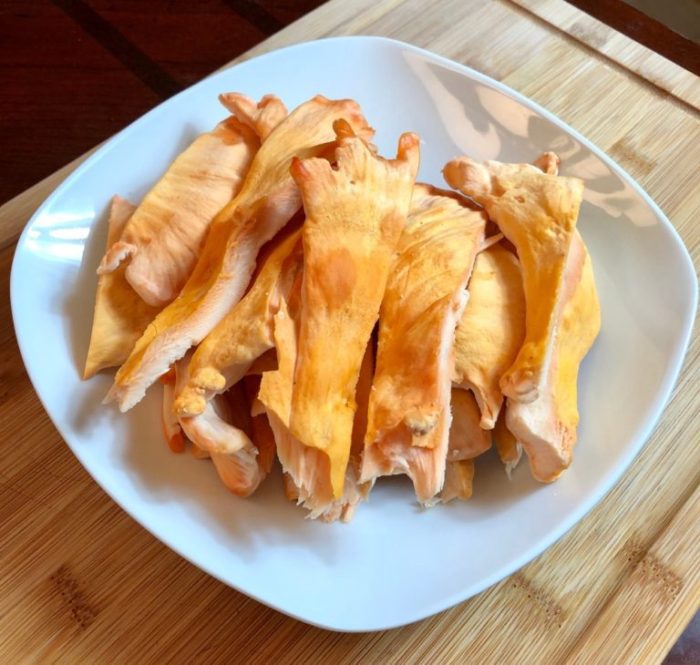
Prepare to delve into the captivating world of Chicken of the Woods recipe, where culinary enthusiasts embark on a delightful journey exploring the distinct flavors and versatility of this remarkable mushroom. From its vibrant hues to its delectable taste, Chicken of the Woods offers a unique culinary experience that will tantalize your taste buds and inspire your creativity in the kitchen.
Step into a realm of culinary possibilities as we uncover the secrets of preparing Chicken of the Woods. Discover innovative recipes, explore its nutritional value, and learn the art of foraging and identifying this exceptional mushroom. Whether you’re a seasoned chef or a novice in the kitchen, this comprehensive guide will equip you with all the knowledge and inspiration you need to elevate your culinary creations with Chicken of the Woods.
Introduction to Chicken of the Woods
The Chicken of the Woods (Laetiporus sulphureus) is a striking mushroom that stands out in the culinary world for its vibrant appearance and delectable flavor. This remarkable fungus adorns trees and logs, showcasing an array of vibrant hues that range from bright orange to golden yellow.
Its unique fan-shaped structure and tender, meaty texture have earned it a reputation as a culinary gem.
Beyond its captivating aesthetics, Chicken of the Woods holds a special place in the culinary realm. Its meaty texture and delicate flavor profile make it a versatile ingredient that can be enjoyed in a myriad of dishes. Whether grilled, sautéed, or roasted, this mushroom imparts a savory umami flavor that elevates any meal.
Culinary Significance
The culinary significance of Chicken of the Woods stems from its exceptional taste and texture. Its meaty consistency and mild flavor make it an excellent substitute for chicken in various recipes. This versatility has led to its widespread use in vegetarian and vegan dishes, where it provides a satisfying and flavorful alternative to animal products.
Furthermore, Chicken of the Woods boasts a rich nutritional profile. It is a good source of protein, fiber, and vitamins, making it a healthy addition to any diet. Its high antioxidant content also contributes to its nutritional value, offering potential health benefits.
Recipe Variations for Chicken of the Woods
Chicken of the woods is a versatile mushroom that can be prepared in various ways. From classic sautéing to innovative grilling and roasting methods, this mushroom offers a range of culinary possibilities. Here are some creative recipe ideas to showcase its versatility:
Sautéing
Sautéing is a quick and easy way to cook chicken of the woods. Simply heat some oil in a pan, add the mushrooms, and cook until browned and tender. You can season them with your favorite herbs and spices for added flavor.
Here’s a step-by-step guide to a classic sautéed chicken of the woods recipe:
- Clean the mushrooms and cut them into bite-sized pieces.
- Heat olive oil in a large skillet over medium heat.
- Add the mushrooms to the pan and cook for 5-7 minutes, or until they start to brown.
- Season with salt, pepper, and any other desired herbs or spices.
- Continue cooking for another 2-3 minutes, or until the mushrooms are tender.
- Serve immediately with your favorite sides.
Health Benefits and Nutritional Value
Chicken of the Woods is renowned for its exceptional nutritional content and potential health benefits. It boasts an impressive array of essential vitamins, minerals, and antioxidants, making it a valuable addition to a balanced diet.
One of the most notable benefits of Chicken of the Woods is its ability to support immune function. It contains a high concentration of beta-glucans, which are known to stimulate the production of immune cells and enhance the body’s ability to fight off infections.
Anti-inflammatory Properties
Furthermore, Chicken of the Woods possesses anti-inflammatory properties. It contains compounds that have been shown to reduce inflammation throughout the body, potentially alleviating symptoms associated with conditions such as arthritis and asthma.
Essential Vitamins and Minerals
Chicken of the Woods is also an excellent source of essential vitamins and minerals. It is particularly rich in vitamin C, which is crucial for immune health, skin health, and antioxidant protection. Additionally, it provides significant amounts of potassium, which is important for maintaining electrolyte balance and regulating blood pressure.
Foraging and Identification Tips: Chicken Of The Woods Recipe

Foraging for Chicken of the Woods can be a rewarding experience, but it’s essential to do so responsibly and safely. Here are some tips to help you identify and harvest Chicken of the Woods sustainably:
Identification
- Appearance:Chicken of the Woods typically grows in clusters on dead or dying hardwood trees, such as oaks, maples, and beeches. The mushroom has a bright orange to yellow coloration, with a wavy or lobed shape.
- Spores:The underside of the mushroom is covered in small, white pores, rather than gills.
- Size:Chicken of the Woods can vary in size, but it often grows to be several inches across.
Safety Precautions
Always be cautious when foraging for wild mushrooms. Some poisonous mushrooms can resemble Chicken of the Woods, so it’s important to be able to identify the mushroom correctly before consuming it. If you’re unsure about a mushroom, it’s best to leave it alone.
- Consult an expert:If you’re new to foraging, consider consulting with an experienced mushroom forager or joining a guided foraging group.
- Use a field guide:Carry a reliable field guide with you when foraging to help you identify mushrooms.
- Harvest sustainably:Only harvest a portion of the mushroom cluster, leaving the rest to grow and reproduce.
Culinary Applications and Pairing Suggestions

Chicken of the Woods is a versatile culinary ingredient with a unique flavor and texture. Its meaty consistency makes it an excellent substitute for chicken or other meats in various dishes.
In soups and stews, Chicken of the Woods adds a savory depth of flavor and umami. Its ability to absorb liquids makes it an ideal addition to broths and sauces, where it infuses its distinctive taste. Salads benefit from the mushroom’s meaty texture, adding a satisfying bite to greens and vegetables.
If you’re looking for a unique and delicious vegetarian meal, check out this chicken of the woods recipe . This edible mushroom has a meaty texture and a savory flavor, making it a great substitute for chicken in many dishes.
You can find this recipe and more at the link provided.
Pasta Pairings
Chicken of the Woods shines in pasta dishes, complementing the richness of sauces and the al dente texture of pasta. Its earthy flavor pairs well with creamy sauces, such as Alfredo or mushroom cream sauce. In tomato-based sauces, the mushroom’s umami enhances the acidity of the tomatoes, creating a balanced and flavorful dish.
Complementary Flavors, Chicken of the woods recipe
The robust flavor of Chicken of the Woods pairs well with a variety of herbs and spices. Thyme, rosemary, and sage enhance its earthy notes, while garlic and onion add a savory depth. A hint of lemon juice or white wine can brighten the flavor profile, balancing the mushroom’s richness.
Meat Substitute
Chicken of the Woods is an excellent meat substitute in vegetarian or vegan dishes. Its meaty texture and umami make it a convincing alternative to chicken in stir-fries, tacos, or curries. In addition, the mushroom’s high protein content makes it a nutritious and satisfying plant-based option.
Have you ever heard of a chicken of the woods? It’s a type of mushroom that looks just like a chicken. You can find it in the woods during the summer and fall. If you’re looking for a unique and delicious way to cook chicken of the woods, check out this chicken of the woods recipe . It’s easy to follow and will give you a delicious meal that you’ll love.
Outcome Summary

As we conclude our exploration of Chicken of the Woods recipe, we leave you with a newfound appreciation for the culinary wonders this unique mushroom holds. Its versatility, nutritional benefits, and distinct flavors make it a must-have ingredient for any adventurous cook.
Whether you sauté it, grill it, or roast it, Chicken of the Woods promises an unforgettable gastronomic experience. So, embrace the culinary journey, experiment with different recipes, and discover the endless possibilities that await you with Chicken of the Woods.
FAQ Section
Is Chicken of the Woods safe to eat?
Yes, Chicken of the Woods is generally safe to eat when properly identified and cooked. However, it’s important to note that some people may experience allergic reactions.
How can I identify Chicken of the Woods?
Look for bright orange or yellow shelf-like clusters with a velvety texture. The underside should have small, white pores.
What are the health benefits of Chicken of the Woods?
Chicken of the Woods is a good source of fiber, antioxidants, and essential vitamins and minerals. It may support immune function and reduce inflammation.





